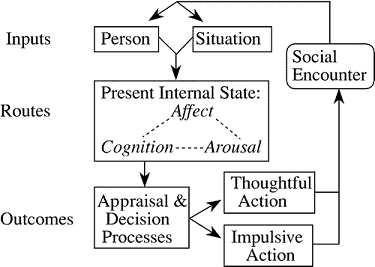Part 2 of https://steemit.com/aggression/@psychnmore/video-games-nv-influence-on-aggressive-cognition-part-1
4. Psychological Theories of Aggression
Social Learning Theory
Bandura (1973, 1977, 2001) proposed that people learn behaviours by observing, imitating and modelling. The social learning theory combines attention, memory and motivation, which means it holds elements of cognitive and behaviour psychology.
In his publications Bandura explained the social learning theory as a continuous reciprocal interaction between cognitive, behavioural and environmental influences.
The people observed are described as the models and have to fulfil certain conditions for effective modelling. Those conditions are attention. Retention, the ability to remember to what attention was paid to. It also includes symbolic coding, cognitive organisation, rehearsal, and mental images. The next condition is reproduction of learned behaviour and self-observation while reproducing. And there needs to be Motivation, a reason to imitate the observed.
For aggression this means that people learn or experience aggression and reproduce the observed and experienced. With the fitting motivation.
This also works for violence in video games. The characters in a video game become the models the players observe, and without other models that refuse the social behaviour presented, the player will memorise the aggressive action presented as an action that is socially acceptable and not considered as negative. It is learning through observation like Huesmann wrote in an comment on Anderson et al. (2010) study.
Cognitive Neoassociation Theory

Figure 1: Simplified associative network with aggression concepts and a retaliation script (from Anderson et al. 1998).
The cognitive neoassociation theory proposed by Berkowitz (1989, 1993) explains aggression as a result of accumulated negative events, like loud noise, provocations, frustration or bad smells, that will stimulate various thoughts, memories, and physiological responses that can be connected to the fight or flight mechanisms in humans. With the fight mechanisms comes a rise of anger, while flight mechanisms are connected to fear.
So in this means that aggressive thoughts, emotions and behaviour are linked together in memories. Figure 1 by Anderson et al. (1998) is simple version of a associative memory link. Linking the concept of a gun to other aggressive concepts. The thick lines represent strong associations with the concept, while the length of the lines present the similarity.
The theory also includes cognitive processes that appraise and attribute. Leading to analysing how someone feels and why, if a motivation is present. This will lead to clearer defined feelings of anger or fear. Which means the cognitive neoassociation theory explains why negative events increase the aggressive cognition (Berkowitz, 1989).
And when looking at the figure 1 and the memory links it is clear that learning is involved. If put into context with violent video games and the influence on aggression, the games teach the players new association or strengthens those already present between aggressive concepts, which leads to an increase in aggressive cognition.
Script Theory
With the script theory it was proposed that children, that observe violence and aggression in the mass media, learn aggressive scripts. These learned scripts will define certain situations and the behaviour of the response to the situation. It is a system of guidance. Huesmann (1986, 1998) explained that once a script is learned it can be retrieved at a later date to evaluate a situation and guide the behaviour of the actor. The theory is strongly related to the social learning theory proposed by Bandura (1977).
And as video games are part of the mass media the theory predict the influence of violent video games on aggression. But it is harder to explain the influence non-violent video games can have on aggressive cognition and behaviour, as there is no violent content in those games. Still there are players that can show aggression when playing non-violent games, because violence is also part of the perception and people have different views. For some even a light provocation or accidentally being bumped into is aggressive behaviour and they will use scripts learned to deal with the perceived aggression.
The script theory also connects to the neoassociation theory as scripts are highly associated concepts in memory. Linking different concepts and goals together (Abelson, 1981). And once the scripts are part of the memories, they will influence and change the expectation, intention and reaction to certain social behaviour. This also means that the more often a script is used the stronger it becomes and the more connection to other related scripts will be created. Until the observed behaviour of solving a problem with violence seems to fit even if the situation is different from the originally observed.
5. General Aggression Model (GAM)

Figure 2: GAM Episodic Processes (DeWall, Anderson and Bushman, 2011)
Considering the work of Anderson and Bushman (2001, 2002) it is also possible to distinguish between the proximate and ultimate goal of aggressive behaviour. And with the theories on aggression mentioned in Section 4, the aggressive behaviour, emotions and cognition can be explained. But it would to decide which theory to use for a situation and to ignore other theories that could explain the aggressive cognition and behaviour in a certain situation.
A framework was needed to combine several theories on aggression and over the last 40 years the general aggression model (GAM) was developed. A model that combines theories of social cognitive and social learning theories. And considered situational, personal and biological factors. Psychologists like Bandura (1977), Berkowitz (1989, 1993), or Huesmann (1998) took part in developing the GAM. Their understanding of aggression and behaviour created the GAM as a tool to understand the learning and development involved in shaping aggressive behaviour and how it can override the part of the process that would hold the actor back by realising that the behaviour is appropriate.
When looking at figure 2 (DeWall, Anderson and Bushman, 2011), the process clearly depends on the cognition of the person. How the person perceives and interprets the environment, people and their behaviour in it. Also which expectations for outcomes are processed in a individuals mind are important.
It can also be seen in figure 2 that the GAM focuses on the development and use of knowledge structures. Knowledge influences both the early parts of the model, like the visual perception of a behaviour and also the later when it comes to judgements and decision making (Higgins, 1996; Bargh, 1996). Understanding these cognitive processes and considering studies by Higgins (1996) or Wegner and Bargh (1998), the proposed key features like the experience, the levels of perception, the personal influence, scripts and behaviour of an individual are a important part of the GAM. These things allow an understanding of the situational aggression and what might happen within a person. As humans show similarities in reacting to a certain situation.
So the main features of the GAM and the figure 2, are the personal and situational influences, the routes these influences take to have impact on the person and the outcomes of the persons appraisal and decisions.
This allows a general understand of aggression in different contexts. From the intimate aggression and violence between partners (DeWall, Anderson and Bushman, 2011), to the aggression created by the mass media, including video games. And with consideration of the perception and situation it can also explain change in the aggressive cognition or behaviour when playing video games without violent content because other factors from the outside of the game (e.g. loud noise, a bad day) in combination with a perceived provocation in the game could create a change.
Or in case of violent video games it could be that the constant rehearsal of the situations in a game, as it is often played again and again, could be part of a change in the scripts and concepts of a person that would lead to a different perception, appraisal and decision making. Cooper (1999) wrote an article about a cop shooting an innocent Afro American, which applies to the influence of learned knowledge on violence, and Plant and Peruche (2005) presented study on the "first shoot, then ask questions" mentality that could have been learned. In both cases learning through video games, violent or non-violent, could be part of the process that could have lead to a change in the scripts that guide the appraisal of a situation and the resulting decision on how to behave. All it would have needed was to perceive a behaviour as aggressive and be experience this situation and behaviour repentantly.
This the core of the General Aggression Model. There are additions to the GAM that account for decision making and the individuals personality (Anderson and Bushman, 2002) . Or the addition of DeWall, Anderson and Bushman (2011) which added the possibility to use the model on violence.
6. Personal and situational Factors
As already mentioned the GAM considers inputs and factors of situational and personal level. Those inputs are of proximate nature, but goal of a decision and the resulting behaviour can be ultimate(Tooby and Cosmides, 1992).
Personal factors are for example traits, gender, beliefs, values and scripts. Aggression differs in gender. Especially the preferred type of aggression differs between males and females. Oesterman et al (1998) or Hess and Hagen (2006) showed in their studies that males prefer direct aggression and women tend to indirect aggression.
Beliefs are connected to Bandura (1977) and learning as the individual learns aggressive behaviour and scripts that will guide his preparedness and reaction in certain situations, the individual will become more confident in successfully performing the aggressive behaviour and that the outcome will be what is desired. Considering Patterson et al (1992) the family is the resource for children to have those inputs. With the development of technology and the availability of computer games or video games a new resource for observing those inputs is added to the family (Livingstone, 2002).
Connected to the beliefs are the values of what individuals belief they should or should not do. This is also a cultural input as the preferred method to deal with a provocation (e.g. an insult to the honour) can be different from culture to culture. In the southern United States such an insult to a persons honour must have an reaction. Preferable of aggressive nature (Nisbett and Cohen, 1996).
As for the situational factors they are factors of context. For example if there is a provocation, pain, drugs or frustration. Both the personal and situational factors influence an individual's aggression with a manipulation of cognition, arousal and emotions.
Looking at provocation it is easy to relate to violent video games as the player observers how the characters in a game react to a provocation and how he is rewarded if doing so himself. Cowie et al. (2001) looked into provocation on the workplace in form of violence, aggression and bullying. A concept that can be applied to the life of children and young adults (Ragatz, Anderson, Fremouw and Schwartz, 2010). Now considering there are games that promote bullying the aggressive behaviour is strengthened in young people. But is hardly the sole reason for bullying as school bullies existed before video games were available.
Frustration on the other hand can be considered as a general factor when looking at all video games and not only those with violent content. As frustration is considered the blockage from achieving a personal goal. In video games it can be the high score. So a non-violent game can frustrate a players. It is one of the factors in this study. As the rising difficulty of a game will stop the player from achieving their goals and build up frustration that could influence the aggressive cognition of the player.
!As always. Errors in spelling etc. are possible as English is not my native language.!
Part 3 will be online next Sunday.
nice post